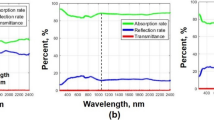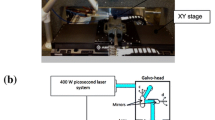Abstract
Laser processing of polycrystalline porous graphite through micro- to millisecond pulses with 1 µm wavelength is investigated. The study aims at finding the best compromise between the efficiency of the process (ablation rate) and the quality (reduced heat-affected zone) for drilling and cutting applications. Our experimental approach is based on experiments involving a monomode kW ytterbium fibre laser (1080 nm) coupled with a laser scanning system. This system is used for parametric studies on pulse duration, power, repetition rate and scanning speed on samples that are analysed with scanning electron microscopy. To improve the understanding of the underlying physical phenomena and processes involved, a finite element numerical model is developed, taking into account energy deposition through optical ray tracing, heat transfer, sublimation of the material and crater formation. Based on these experimental and numerical tools, we identify some optimum parameters to fabricate high aspect ratio shapes in graphite samples of 1.5 mm thickness with excellent edge quality and minimal heat-affected zone. Laser processing under vacuum atmosphere is also studied and exhibit no difference in behaviour compared to ambient atmosphere.











Similar content being viewed by others
References
M.D. Shirk, P.A. Molian, A review of ultrashort pulsed laser ablation of materials. J. Laser Appl. 10, 18 (1998). https://doi.org/10.2351/1.521827
B.N. Chichkov, C. Momma, S. Nolte, F. von Alvensleben, A. Tünnermann, Femtosecond, picosecond and nanosecond laser ablation of solids. Appl. Phys. A 63, 109 (1997). https://doi.org/10.1007/BF01567637
A.K. Dubey, V. Yadava, Laser beam machining—A review. Int. J. Mach. Tools Manuf. 48, 609 (2008). https://doi.org/10.1016/j.ijmachtools.2007.10.017
S. Preuss, A. Demchuk, M. Stuke, Sub-picosecond UV laser ablation of metals. Appl. Phys. A 61, 33 (1995). https://doi.org/10.1007/BF01538207
P.P. Pronko, S.K. Dutta, J. Squier, J.V. Rudd, D. Du, G. Mourou, Machining of sub-micron holes using a femtosecond laser at 800 nm. Opt. Commun. 114, 106 (1995). https://doi.org/10.1016/0030-4018(94)00585-I
S. Küper, M. Stuke, Ablation of polytetrafluoroethylene (Teflon) with femtosecond UV excimer laser pulses. Appl. Phys. Lett. 54, 4 (1989). https://doi.org/10.1063/1.100831
J. Ihlemann, B. Wolff, P. Simon, Nanosecond and femtosecond excimer laser ablation of fused silica. Appl. Phys. A 45, 363 (1992). https://doi.org/10.1007/BF00324203
J. Ihlemann, A. Scholl, H. Schmidt, B. Woltf-Rottke, Nanosecond and femtosecond excimer-laser ablation of oxide ceramics. Appl. Phys. A 60, 411 (1995). https://doi.org/10.1007/BF01538343
M.N.R. Ashfold, F. Claeyssens, G.M. Fuge, S.J. Henley, Pulsed laser ablation and deposition of thin films. Chem Soc Rev 33, 23 (2004). https://doi.org/10.1039/B207644F
D.H. Lowndes, D.B. Geohegam, A.A. Puretzky, D.P. Norton, C.M. Rouleau, Synthesis of novel thin-film materials by pulsed laser deposition. Science 273, 898–903 (1996). https://doi.org/10.1126/science.273.5277.898
P.R. Willmott, J.R. Huber, Pulsed laser vaporization and deposition. Rev. Mod. Phys. 72, 315 (2000). https://doi.org/10.1103/RevModPhys.72.315
M. Malinauskas, M. Farsari, A. Piskarskas, S. Juodkazis, Ultrafast laser nanostructuring of photopolymers: a decade of advances. Phys. Rep. 533, 1 (2013). https://doi.org/10.1016/j.physrep.2013.07.005
K.C. Phillips, H.H. Gandhi, E. Mazur, S.K. Sundaram, Ultrafast laser processing of materials: a review. Adv. Opt. Photonics 7, 684 (2015). https://doi.org/10.1364/AOP.7.000684
V. Oliveira, S. Ausset, R. Vilar, Surface micro/nanostructuring of titanium under stationary and non-stationary femtosecond laser irradiation. Appl. Surf. Sci. 255, 7556–7560 (2009). https://doi.org/10.1016/j.apsusc.2009.04.027
T.H. Her, R.J. Finlay, C. Wu, S. Deliwala, E. Mazur, Microstructuring of silicon with femtosecond laser pulses. Appl. Phys. Lett. 73, 1673 (1998). https://doi.org/10.1063/1.122241
F. Xiong, Y.Y. Wang, R.P.H. Chang, Complex dielectric function of amorphous diamond films deposited by pulsed-excimer-laser ablation of graphite. Phys. Rev. B 48, 8016 (1993). https://doi.org/10.1103/physrevb.48.8016
Á. Mechler, P. Heszler, Z. Kántor, T. Szörényi, Z. Bor, Excimer laser irradiation induced formation of diamond-like carbon layer on graphite. Appl. Surf. Sci. 138, 174 (1999). https://doi.org/10.1016/S0169-4332(98)00397-3
H. Togashi, K. Aoki, M. Mukaida, T. Kameyama, Formation of large carbon cluster ions at graphite (HOPG) surfaces by laser irradiation. Appl. Surf. Sci. 96, 276 (1996). https://doi.org/10.1016/0169-4332(95)00431-9
P. Patsalas, S. Kaziannis, C. Kosmidis, D. Papadimitriou, Optimized pulsed laser deposition by wavelength and static electric field control: The case of tetrahedral amorphous carbon films. J Appl Phys 101, 124903 (2007). https://doi.org/10.1063/1.2745445
C.B. Collins, F. Davanloo, E.M. Juengermañ, D.R. Jander, T.J. Lee, Preparation and study of laser plasma diamond. Surf. Coat. Technol. 47, 244 (1991). https://doi.org/10.1016/0257-8972(91)90287-7
S.E. Johnson, M.N.R. Ashfold, M.P. Knapper, R.J. Lade, K.N. Rosser, N.A. Fox, W.N. Wang, Production and characterisation of amorphic diamond films produced by pulsed laser ablation of graphite. Diam. Relat. Mater. 6, 569 (1997). https://doi.org/10.1016/S0925-9635(96)00660-7
J. J. Cuomo, D. L., Pappas, J., Bruley, J. P., Doyle, K. L. Saenger, Vapor deposition processes for amorphous carbon films with sp3 fractions approaching diamond. J. Appl. Phys. 70, 1706 (1991). https://doi.org/10.1063/1.349540
C. Bower, S. Suzuki, K. Tanigaki, O. Zhou, Synthesis and structure of pristine and alkali-metal-intercalated single-walled carbon nanotubes. Appl. Phys. A 67, 47 (1998). https://doi.org/10.1007/s003390050736
R. Rozman, I. Grabec, E. Govekar, Influence of absorption mechanisms on laser-induced plasma plume. Appl. Surf. Sci. 254, 3295 (2008). https://doi.org/10.1016/j.apsusc.2007.11.029
L.D. Thomas, R.K. Nesbet, Low-energy electron scattering by atomic carbon. Phys. Rev. A 12, 2378 (1975). https://doi.org/10.1103/PhysRevA.12.2378
H., Munjal, K. L., Baluja, Elastic and excitation processes of electron impact on C3 using the R-matrix method. J. Phys. B: At. Mol. Opt. Phys. 39, 3185 (2006). https://doi.org/10.1088/0953-4075/39/16/004
Halmova, G., Gorfinkiel, J. D., Tennyson, J., Low-energy electron collisions with C2 using the R-matrix method. J. Phys. B: At. Mol. Opt. Phys. 39, 2849 (2006). https://doi.org/10.1088/0953-4075/39/12/018
J. Hoffman, T. Moscicki, Z. Szymanski, Acceleration and distribution of laser-ablated carbon ions near the target surface. J. Phys. D: Appl Phys 45, 025201 (2012). https://doi.org/10.1088/0022-3727/45/2/025201
M.D. Shirk, P.A. Molian, Ultra-short pulsed laser ablation of highly oriented pyrolytic graphite. Carbon 39, 1183 (2001). https://doi.org/10.1016/S0008-6223(00)00236-0
J. Hoffman, J. Chrzanowska, S. Kucharski, T. Moscicki, I.N. Mihailescu, C. Ristoscu, Z. Szymanski, The effect of laser wavelength on the ablation rate of carbon. Appl. Phys. A 117, 395 (2014)
D. Lee, R. Patwa, H. Herfurth, J. Mazumder, High speed remote laser cutting of electrodes for lithium-ion batteries: Anode. J. Power Sources 240, 368 (2013). https://doi.org/10.1016/j.jpowsour.2012.10.096
A. H. A., Lutey, A., Fortunato, A., Ascari, S., Carmignato, L., Orazi, Pulsed Laser Ablation of Lithium Ion Battery Electrodes. Proceedings of the ASME 2014 International Manufacturing Science and Engineering Conference collocated with the JSME 2014 International Conference on Materials and Processing and the 42nd North American Manufacturing Research Conference. Volume 2: Processing (2014). https://doi.org/10.1115/MSEC2014-3967
B., Schmieder, Laser cutting of graphite anodes for automotive lithium-ion secondary batteries: investigations in the edge geometry and heat affected zone. Proceedings Volume 8244, Laser-based Micro- and Nanopackaging and Assembly VI; 82440R (2012). https://doi.org/10.1117/12.912767
M. Luetke, V. Franke, A. Techel, T. Himmer, U. Klotzbach, A. Wetzig, E. Beyerab, A Comparative Study on Cutting Electrodes for Batteries with Lasers. Phys. Procedia 12, 286–291 (2011). https://doi.org/10.1016/j.phpro.2011.03.135
R., Patwa, H., Herfurth, S., Heinemann, J., Mazumder, D., Lee, Investigation of different laser cutting strategies for sizing of Li-ion battery electrodes. ICALEO 2012, 908 (2012). https://doi.org/10.2351/1.5062562
J.B. Habedank, J. Endres, P. Schmitz, M.F. Zaeh, H.P. Huber, Femtosecond laser structuring of graphite anodes for improved lithium-ion batteries: Ablation characteristics and process design. J. Laser Appl. 30, 032205 (2018). https://doi.org/10.2351/1.5040611
S.V. Garnov, V.I. Konov, T. Kononenko, V.P. Pashinin, M.N. Sinyavsky, Microsecond Laser Material Processing at1.06 μm. Laser Physics 14, 910–915 (2004)
L. Gallais, T. Vidal, E. Lescoute, Y. Pontillon, J.-L. Rullier, High power continuous wave laser heating of graphite in a high temperature range up to 3800 K. J. Appl. Phys. 129, 043102 (2021). https://doi.org/10.1063/5.0033530
L. Robin, P. Combis, P. Cormont, L. Gallais, D. Hebert, C. Mainfray, J.-L. Rullier, Infrared thermometry and interferential microscopy for analysis of crater formation at the surface of fused silica under CO2 laser irradiation. J. Appl. Phys. 111, 063106 (2012)
W.-I. Cho, S.J. Naa, C. Thomy, F. Vollertsen, Numerical simulation of molten pool dynamics in high power disk laser welding. J. Mater. Process. Technol. 212, 262 (2012). https://doi.org/10.1016/j.jmatprotec.2011.09.011
J.-H. Cho, S.-J. Na, Implementation of real-time multiple reflection and Fresnel absorption of laser beam in keyhole. J. Phys. D: Appl. Phys. 39, 5372 (2006). https://doi.org/10.1088/0022-3727/39/24/039
H. Ki, J. Mazumder, P.S. Mohanty, Modeling of laser keyhole welding: Part I. mathematical modeling, numerical methodology, role of recoil pressure, multiple reflections, and free surface evolution. Metall. Mater. Trans. A. 33, 1817–1830 (2002). https://doi.org/10.1007/s11661-002-0190-6
J.Y. Lee, S.H. Ko, D.F. Farson, C.D. Yoo, Mechanism of keyhole formation and stability in stationary laser welding. J. Phys. D: Appl. Phys. 35, 1570 (2002). https://doi.org/10.1088/0022-3727/35/13/320
A. Otto, H. Koch, K.-H. Leitz, M. Schmidt, Numerical Simulations - A Versatile Approach for Better Understanding Dynamics in Laser Material Processing. Phys. Procedia 12, 11 (2011). https://doi.org/10.1016/j.phpro.2011.03.003
P.V. Petkov, S.S. Dimov, R.M. Minev, D.T. Pham, Laser milling: Pulse duration effects on surface integrity. Proc. Inst. Mech. Eng. B 222, 35–45 (2008). https://doi.org/10.1243/09544054JEM840
S. Sinha, Nanosecond laser ablation of graphite: A thermal model based simulation. J. Laser Appl. 30, 012008 (2018). https://doi.org/10.2351/1.5021520
J. Tu, A.G. Paleocrassas, N. Reeves, N. Rajule, Experimental characterization of a micro-hole drilling process with short micro-second pulses by a CW single-mode fiber laser. Opt. Lasers Eng. 55, 275–283 (2014). https://doi.org/10.1016/j.optlaseng.2013.11.002
Author information
Authors and Affiliations
Corresponding author
Additional information
Publisher's Note
Springer Nature remains neutral with regard to jurisdictional claims in published maps and institutional affiliations.
Rights and permissions
About this article
Cite this article
Doualle, T., Reymond, M., Pontillon, Y. et al. Laser ablation of graphite with near infrared microsecond pulses. Appl. Phys. A 127, 722 (2021). https://doi.org/10.1007/s00339-021-04815-z
Received:
Accepted:
Published:
DOI: https://doi.org/10.1007/s00339-021-04815-z




